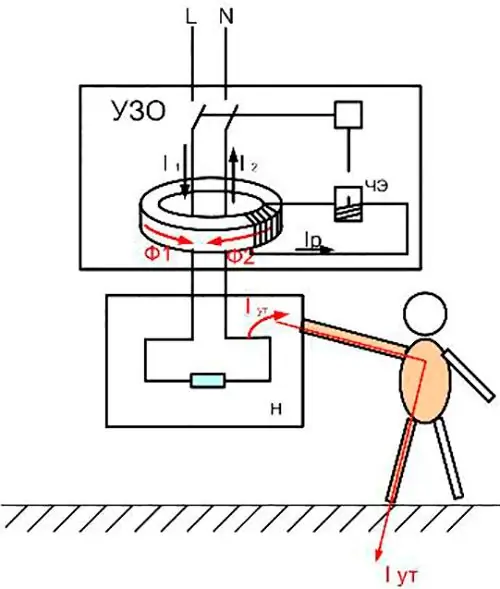- Author Nora Macey [email protected].
- Public 2023-12-16 10:17.
- Last modified 2025-01-23 08:47.
RCD is a residual current device that, when the set values of the differential current are reached or exceeded, must cause the electrical circuit to open. The main tasks of the RCD are: to protect people from electric shocks and to prevent fires caused by current leaks through damaged wiring insulation.

People who have an understanding of the principles of electrical circuits know that circuit breakers that are triggered by short-circuit and overload currents do not react to such a "slight" leak. For a person, an electric shock due to this leakage at a supply voltage of 220 volts can have serious consequences. Theoretically, with such an ular, a current of 220 mA can pass through the human body. In the health and safety reference literature, a value of 100 mA is indicated as can be fatal, so even in theory 220 mA is a very serious danger. To prevent such dangerous leaks, the RCD compares the amount of current leaving consumers with the value of the reverse current and when the specified parameters almost instantly opens the circuit.
In Russia, RCDs are mainly used for installation in an electrical panel on a DIN rail, built-in RCDs are not widely used.
Operating principle
The residual current device is a ferromagnetic core with 3 windings. The current given to consumers flows through the first winding, the reverse current flows through the second. In the normal state, the value of the outgoing current should be equal to the value of the incoming current, the magnetic fields induced by these currents compensate each other, and the total flux is equal to zero. If the sum of the passing currents exceeds the permissible value, the magnetic flux begins to act on the third control winding, forming an induced electromotive force in it, which acts on the opening circuit relay. Modern RCDs, in addition to the core and windings, contain other electronic components, but the described principle of operation is the basis for the operation of residual current devices.
The main types of RCDs
RCDs are single-phase and three-phase, depending on the supply voltage - electronic and independent of it - electromechanical. In addition, residual current devices are divided into 5 types according to the operating conditions.
Since the 1980s, in the United States, most household RCDs have been built into sockets.
Speaker type. The RCD responds to an alternating sinusoidal differential current, which may rise slowly or appear suddenly.
Type A. The residual current device responds to alternating and constant pulsating differential currents, which can also appear suddenly or slowly increase.
Type B. The device responds to alternating, direct and rectified differential currents.
Type S and G. The RCD has a tripping time delay.






